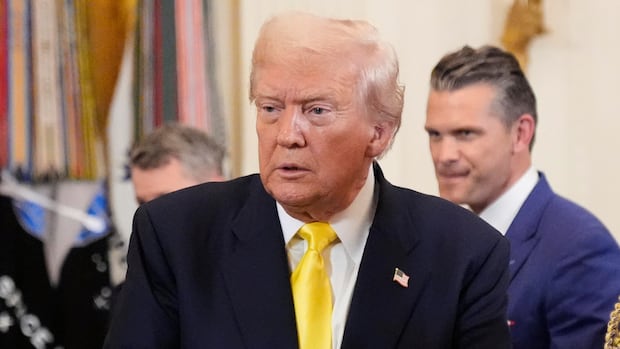
Deal or no deal, Mark Carney has to manage a new relationship with the United States
Published: 2025-08-09 11:41:51 | Views: 10
A week after the latest deadline to somehow resolve the trade war that Donald Trump has launched against Canada — and with Canadian officials now looking ahead to a full renegotiation of the Canada-U.S.-Mexico Agreement — many things remain unclear.
But when Mark Carney spoke to reporters in British Columbia on Tuesday, he expressed clarity about at least one thing.
"While we'll continue to work with the United States on the many mutually beneficial opportunities that we share in trade and investment," the prime minister said, "it is clear that we cannot count, or fully rely, on what has been our most-valued trading relationship, for our prosperity."
Such comments follow from Carney's insistence in March that Canada's "old relationship" with the United States was "over." And it remains remarkable to hear a prime minister talk this way about this country's largest trading partner and closest ally, with whom Canada has spent most of the last century growing steadily closer.
But it's also increasingly hard to dispute.
"And that's why," Carney continued on Tuesday, "we're increasingly focused on building our strength at home and finding new opportunities for Canadian companies and workers abroad."
Carney will still obviously be judged on how he navigates the current dispute. But deal or no deal — tariffs or no tariffs — the larger question is how Canada should navigate this new world.
What does a 'deal' with Trump look like?
In some ways, Canada's moment of crisis seemed to deflate over the last couple months.
Trump is talking less about annexing Canada. Some of his tariffs have turned out to be lower than he originally threatened. And Canada's exports are, overall, facing a lower level of tariffs than many other countries.
But there are still tariffs. The effective overall tariff rate imposed by the United States on imports is now estimated to be 18.6 per cent — the highest it has been since 1933. For Canada, the effective rate is estimated to be 13.1 per cent.
"You should think of Trump's trade policy as the second coming of the 1930 Smoot-Hawley tariff, effectively reversing the results of 90 years of trade liberalization," economist Paul Krugman wrote this week.
Contrary to speculation that Trump was just wielding tariffs as a bargaining tactic, he's making import taxes a feature of the "deals" he is signing with other countries. He is apparently willing to accept the risks to the American economy and the additional costs that will be imposed on American households, to say nothing of the damage done to relations between the United States and other countries.
"The U.S. is in the process of fundamentally changing all of its trading relationships," Carney said. "In a series of agreements, America is, in effect, charging for access to its economy through a combination of higher baseline tariffs, unilateral trade liberalization by its partners and new commitments to invest in the United States."
Conservative Leader Pierre Poilievre tried to blame Carney this week for the continued presence of American tariffs and accused the prime minister of "bending over backwards" to make concessions to the American president. He also said the goal should still be "unfettered access to the American market."
Those comments are at least a reminder of how much Carney might have at stake in the current negotiations and in the negotiations to come — though it remains to be seen how much the Canadian public expects from Carney in this situation.
Of course, even if Carney's government is able to come to an agreement with the Trump administration, the available evidence suggests any deal is subject to change. Similarly, it would now seem naive to imagine that some kind of durable pre-2016 normalcy will return if or when Trump is no longer president.
Is it time for a new third option?
The push and pull of Canada's relationship to the United States is one of the strongest through lines of Canadian history. But the current moment may have something in common with where Canada briefly found itself in 1972.
Fifty-three years ago, Mitchell Sharp, then secretary of state for external affairs, put his name to a 24-page paper entitled, Canada-U.S. Relations: Options for the Future. Against the backdrop of a shifting global order, concerns about Canadian economic and cultural independence and a series of sudden moves by the American administration, Sharp surmised that Canada had three options.
First, Canada could continue with the status quo, managing its relations with the United States on a case-by-case basis and dealing with problems as they arose. Second, Canada could "move deliberately toward closer integration with the United States," possibly via a free trade deal. Alternatively, Canada could "pursue a comprehensive long-term strategy to develop and strengthen the Canadian economy and other aspects of its national life and in the process to reduce the present Canadian vulnerability."
While Sharp was advocating for the third scenario, Canadians, under a different government, eventually went with the second course. And what came to be known as the "third option" fell into some disrepute, associated with some of Pierre Trudeau's more nationalistic economic interventions and an ill-fated pursuit of new trade partners.
There's no evidence that Carney has taken any particular inspiration from the third option. But Sharp's description reads somewhat like a wordier way of saying "Canada strong" — the Liberal campaign slogan in the spring's election. (For that matter, it's perhaps broadly in line with some of what Poilievre has said about the need to strengthen the Canadian economy.)
In Sharp's own later judgement, his paper helped to marshal public support for Canadian cultural institutions, but "did not … bring about any significant change in the direction of our trade." And while it "implied an internal restructuring of the Canadian economy to reduce our dependence on the United States" that "wasn't attempted and probably was too difficult to achieve given the overlapping jurisdictions of the federal and provincial governments."
For Canada, trade diversification qualifies as one of those things that, if it was easy to do, someone would have done by now. Indeed, efforts by Pierre Trudeau's government to build bridges to new markets might be regarded as a "warning sign" that "what the government wants and what private investment wants are often at odds," says Asa McKercher, a research chair in Canada-U.S. relations at St. Francis Xavier University.
Carney arguably starts from a better position, McKercher says, because Canada is now operating with a number of comprehensive free trade agreements with partners beyond the United States.
"Where the rubber will hit the road is will there be serious efforts to actually get Canadian companies, particularly small and medium businesses, the business links and actually capitalize on these trade agreements," McKercher says.
"If I were the Carney government, if I were to learn something from the third option, particularly in the trade diversification, I'd say you actually have to make a serious effort at actually linking Canadian businesses to other businesses and government agencies."
It's likely still necessary to be realistic about what's possible. Even Sharp conceded that "the United States would almost certainly remain Canada's most important market and source of supply by a very considerable margin." The third option, he wrote, would merely be directed toward "reducing Canada's vulnerability, particularly in relation to the United States."
But in 1972, that was merely an option. In 2025, it might feel like a necessity.
Source link








